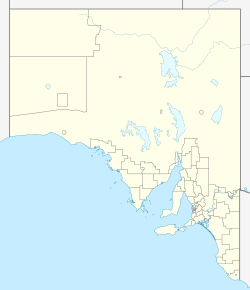Unnamed island, Baird Bay facts for kids
| Geography | |
|---|---|
| Location | Great Australian Bight |
| Coordinates | 33°04′52″S 134°17′04″E / 33.08115°S 134.28437°E |
| Area | 13 ha (32 acres) |
| Administration | |
|
Australia
|
|
Unnamed Island, Baird Bay is a special island in South Australia. It's located in Baird Bay, about 32 kilometers (20 miles) southwest of Streaky Bay. This island is on the western coast of the Eyre Peninsula. It has been a protected area since 1967 and is part of the Baird Bay Islands Conservation Park since 1972. This means it's a safe place for nature.
Contents
About Unnamed Island
This unnamed island sits at the northern end of Baird Bay. It is about 10 kilometers (6 miles) northwest of the town of Baird Bay and 32 kilometers (20 miles) southwest of Streaky Bay. The island is made of a type of rock called calcarenite. This rock platform slopes down to a sandy beach that goes around most of the island.
On the south side, the waves have created a rocky ledge. A sand bar, called a spit, connects the island to the mainland. At very low tide, this spit dries out, allowing people to walk to the island.
How the Island Formed
This island was formed about 6,000 years ago. This happened when sea levels rose at the start of the Holocene period. The island is mostly made of an exposed layer of calcarenite rock. The water around the island is not very deep, less than 5 meters (16 feet) in most places.
Plants and Animals
The island is home to many different kinds of plants and animals.
Island Plants (Flora)
In 1979, scientists studied the island's plants. They found two main types of plant areas. One area was a "low shrubland" with lots of umbrella bush. The other area was a more open "grassland."
They found 39 different plant species on the island. Some of these include sticky hop-bush, shore westringia, black-anther flax lily, Australian hollyhock, and different kinds of speargrass. Some plants, like bearded oat, were brought to the island by people.
Island Animals (Fauna)
The island has mammals, birds, and reptiles.
Mammals
Three types of mammals found here were brought by humans. These are the house mouse, European rabbit (only bones found), and red fox (tracks seen).
In 1982, a group of ten brush-tailed bettongs were released onto the island. Bettongs are small, native marsupials that were once critically endangered. This group grew to about 20 bettongs. However, in 1994, an animal that seemed like a fox crossed from the mainland and sadly destroyed the bettong population.
Birds
Many bird species have been seen on the island. As of 2006, these include:
- Australian pelican
- black-faced cuckooshrike
- double-banded plover
- fairy tern
- little egret
- osprey
- pied cormorant
- pied oystercatcher
- red-capped plover
- Richard's pipit
- singing honeyeater
- silver gull
- sooty oystercatcher
- stubble quail
- swamp harrier
- welcome swallow
- white-bellied sea eagle
Reptiles
As of 2006, two types of reptiles were found on the island:
Island History
This island does not have an official name. It is sometimes called "Section 181, Hundred Wrenfordsley, County of Robinson" in official records. One source used the name "Baird Bay Island" to tell it apart from other unnamed islands.
In the past, early farmers cleared some of the native plants on the island for grazing their animals. There is a small stone hut built into a cliff on the island. It might have been used by fishermen. Only a limestone chimney remains of another building.
Island Protection
The island first became a protected area on March 16, 1967. It was set aside as a place to protect animals. Since 1972, it has been part of the Baird Bay Islands Conservation Park.
Since 2012, the waters around the island are also protected. They are part of a habitat protection zone within the West Coast Bays Marine Park. The island is also in an area of Baird Bay that has been listed as an important wetland since at least 1996. This listing is in the Directory of Important Wetlands in Australia.


